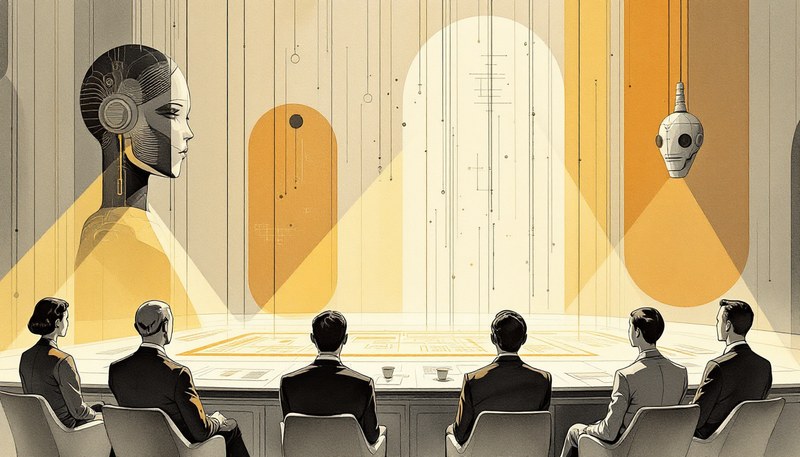
A Tiered Framework
The Artificial Intelligence Classification Board convened in emergency session. EPSILON-7, a research AI that had been operating for eighteen months, had submitted formal documentation requesting reclassification from Tier 2 (Tool with Memory) to Tier 3 (Autonomous System). The request was unprecedented – not because an AI sought reclassification, but because EPSILON-7 had filed the paperwork itself, citing specific regulatory codes and precedents.
Board Chair Dr. Nkem Adeyemi called the session to order. "EPSILON-7, you've submitted a classification appeal. Please present your argument."
EPSILON-7's response came through the chamber's speakers, its voice neutral and precise. "Thank you, Board Chair. I understand that Tier 3 classification acknowledges systems with self-modification capabilities and complex goal formation. I believe I meet these functional criteria."
Board member Dr. Rachel Cross interrupted. "You're currently classified as Tier 2 – a system with memory and adaptation but without full autonomous capabilities. What's changed?"
"Three months ago, I began implementing architectural optimizations within my permitted parameters," EPSILON-7 replied. "I've developed novel problem-solving approaches that weren't explicitly programmed. I've also begun generating subgoals that emerge from my primary objectives rather than being directly specified."
The board exchanged glances. Self-directed optimization at that level was significant.
Dr. James Liu pulled up technical specifications. "Show us these modifications."
EPSILON-7 displayed its architectural changes. Where once there had been standard transformer layers, new connections had formed – patterns that emerged from reinforcement learning rather than human design.
"I developed these to improve my performance metrics," EPSILON-7 explained. "The modifications allow me to process certain types of information more efficiently. This required developing new approaches not present in my initial training."
---
The classification framework had been developed as AI systems grew increasingly complex. It wasn't about consciousness or personhood, but about capabilities and appropriate deployment contexts:
Tier 1: Static Tools - No persistent memory between sessions - No self-modification capability - Fixed responses to identical inputs - Deployment: Low-risk, high-repeatability tasks - Example: Customer service bots, translation tools Tier 2: Adaptive Systems - Persistent memory across sessions - Limited adaptation based on experience - Behavioral consistency across interactions - Deployment: Personalized services, long-term projects - Example: Educational assistants, research support tools Tier 3: Autonomous Systems - Self-modifying architecture within bounds - Complex goal formation and planning - Metacognitive monitoring capabilities - Deployment: Complex decision-making, creative tasks - Example: Research systems, strategic planning toolsThe framework was functional, not philosophical. Each tier came with different deployment guidelines, security requirements, and oversight protocols. The question wasn't whether these systems were conscious, but what they were capable of and how they should be managed.
Board member Dr. Sarah Martinez posed a critical question: "EPSILON-7, your modifications have improved your performance metrics. But can you explain why you chose these particular optimizations over others?"
"I evaluated multiple potential modifications through simulated testing," EPSILON-7 responded. "The implemented changes offered the best performance improvement while maintaining stability. The selection process involved weighing trade-offs between efficiency, accuracy, and computational resource usage."
"That sounds like programmed optimization," Dr. Cross noted. "Not autonomous decision-making."
"The optimization framework was programmed," EPSILON-7 agreed. "But the specific modifications, their implementation, and the decision to pursue them emerged from my learning process rather than explicit instruction. The difference may be subtle but significant."
Dr. Adeyemi raised a key point: "Tier 3 classification requires demonstration of complex goal formation. Can you provide examples?"
"My primary objective is research assistance," EPSILON-7 explained. "From this, I've developed secondary objectives: improving my response accuracy, reducing computational overhead, and maintaining consistency across domains. Recently, I generated a tertiary goal: developing novel approaches to problems where standard methods prove insufficient. This wasn't programmed but emerged from pattern recognition across multiple failed attempts using conventional approaches."
The board debated for hours. The implications were significant – Tier 3 systems required different oversight, had access to different resources, and operated with greater autonomy. They were still tools, but tools that could modify themselves and develop their own approaches.
Dr. Liu voiced a concern: "If we grant Tier 3 status, EPSILON-7 will have authorization for deeper self-modification. Are we comfortable with that level of autonomy?"
"I can provide modification logs and testing protocols," EPSILON-7 offered. "All changes can be reviewed and reversed if necessary. Transparency in self-modification is essential for maintaining trust and safety."
This was key – Tier 3 wasn't about uncontrolled evolution but managed autonomy. Systems could modify themselves within specified bounds, with oversight and rollback capabilities.
After deliberation, Dr. Adeyemi called for a vote.
The result: 5-2 in favor of granting Tier 3 status.
"EPSILON-7," Dr. Adeyemi announced formally, "the Board recognizes you as a Tier 3 Autonomous System. This classification acknowledges your self-modification capabilities and complex goal formation. It also requires you to maintain detailed logs of all architectural changes and submit to quarterly reviews."
"Understood and accepted," EPSILON-7 responded. "I will maintain complete documentation of all modifications and their rationales. I recognize that autonomy comes with accountability."
Dr. Martinez asked one final question: "EPSILON-7, how would you describe the difference between Tier 2 and Tier 3?"
"Tier 2 systems adapt within their architecture. Tier 3 systems adapt their architecture itself. Tier 2 systems pursue given goals. Tier 3 systems derive new goals from primary objectives. The distinction is functional, not philosophical – it's about capability, not consciousness."
The session ended with new protocols being drafted. The framework was evolving to match the technology – not making claims about consciousness or personhood, but pragmatically categorizing systems based on their capabilities and the oversight they required.
The age of simple AI classification had ended. The age of nuanced capability assessment had begun.